Students should refer to Previous Year Questions ICSE Class 10 Physics Magnetism with solutions that have been prepared by expert teachers of ICSE Class 10 Physics. These questions and solutions are based on past year papers that have come in examinations of ICSE Class 10. Students should understand the type of questions asked and the solutions provided. Also refer to ICSE Class 10 Physics Solutions
ICSE Class 10 Physics Magnetism Last Year Questions
Students should learn the important questions and answers given below for Chapter Magnetism in Physics for ICSE Class 10. These board questions are expected to come in the upcoming exams. Students of ICSE Class 10th should go through the board exams questions and answers for ICSE Class 10 Physics which will help them to get more marks in exams.
Board Exam Questions Magnetism ICSE Class 10 Physics
Previous Year Questions ICSE Class 10 Physics Magnetism
Short Answer Type Questions I
Question: (i) Why does a current carrying, freely suspended solenoid rest along a particular direction?
(ii) State the direction in which it rests.
Answer: (i) A current carrying freely suspended solenoid behaves like a bar magnet.
(ii) Geographic North South direction.
Question: (i) Name a common device that uses electromagnet.
(ii) What energy conversion takes place during the working of a DC motor?
Answer: (i) Electric bell uses electromagnet.
(ii) During the working of a DC motor, electrical energy is converted into mechanical energy.
Question: You have been with a solenoid AB.
(i) What is the polarity at end A?
(ii) Give one advantage of an electromagnet over a permanent magnet.

Answer: (i) The polarity at end A is north polarity.
(ii) An advantage of an electromagnet over a permanent magnet is that an electromagnet can produce a strong magnetic field.
Question: The figure given alongside shows an electromagnet.
(i) What will be the polarity at the end X?
(ii) Suggest a way by which the strength of the electromagnet referred to in the question, may be increased.
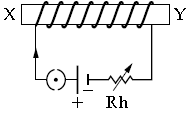
Answer: (i) The polarity at end X is North polarity.
(ii) The strength of the electromagnet can be increased by increasing the strength of the current or by decreasing the resistance in the rheostat.
Question: State two advantage of an electromagnet over a permanent magnet.
Answer: The two advantages of an electromagnet over a permanent magnet are
(i) The polarity of an electromagnet can be changed by reversing the direction of current in the solenoid while polarity of a permanent magnet can never be changed.
(ii) An electromagnet can produce a stronger magnetic field than permanent magnet.
Question: What will happen to a compass needle when the compass is placed below a wire and current is made to flow through the wire? Give a reason to justify your answer.
Answer: The compass needle will show deflection when the compass is placed below a wire and a current is made to flow through the wire. It is so because when a current is passed through a conductor a magnetic field is produced around the conductor due to which compass needle gets deflected.
Question: State the function of split ring in a DC motor.
Answer: The function of a split ring in a DC motor is to flow the current in armature coil in such a way that it always keep on rotating in the same manner.
Question: Why does a magnet needle show a deflection when brought close to a current carrying conductor?
Answer: A current carrying conductor produces a magnetic field around it and the magnetic needle in this
magnetic field experiences a torque due to which it deflects to align itself in the direction of magnetic field.
Question: State the effect of (i) inserting a soft iron core within the coil. (ii) increasing the area of the coil and (iii) increasing the strength of current in the coil of a d.c. motor.
Answer: (i) On inserting a soft iron core within the coil of a d.c. motor, the speed of rotation of coil increases. The reason is that the strength of magnetic field between the pole pieces of magnet increases due to which the deflecting couple on coil increases.
(ii) On increasing the area of coil, the deflecting couple on coil increases, so the speed of rotation of coil increases.
(iii) By increasing the strength of current in the coil, the deflecting couple on the coil increases, so the speed of rotation of the coil increases.
Question: Name three factors on which the magnitude of force on a current carrying conductor placed in a
magnetic field depends and state how does the force depend on the factors stated by you.
Answer: (i) On strength of magnetic field B (F ∝ B)
(ii) On current I in the conductor (F ∝ I) and
(iii) On length l of conductor (F ∝ l)
Question: A d.c. motor is rotating in a clockwise direction. How can the direction of rotation be reversed?
Answer: The direction of rotation of motor can be reversed by reversing the direction of current in the coil i.e.,
by interchanging the connections at the terminals of the battery joined to the brushes of the motor.
Question: A compass needle is placed near a current carrying wire. State your observations for the
following cases, and give reason for the same in each case :
(a) Magnitude of electric current in the wire is increased.
(b) The compass needle is displaced away from the wire.
Answer; (a) Deflection of compass needle increases : Magnetic field strength is directly proportional to
the amount of current.
(b) Deflection of compass needle decreases : Magnetic field strength is inversely proportional to
the distance from wire.
Question: In the experiment to show that a current carrying conductor when placed in the uniform magnetic field experiences force. What happens when :
(a) You reverse the terminals of the battery?
(b) The direction of current is perpendicular to the direction of magnetic field? State your observation.
Answer:(a) On reversing the terminals of the battery, the deflection of rod will be in opposite direction.
(b) When the direction of current is perpendicular
to the direction of magnetic field, then the rod will experience maximum force.
Question: (a) Two magnets are lying side by side as shown below. Draw magnetic field lines between poles P and Q.

(b) What does the degree of closeness of magnetic field near the poles signify?
Answer:
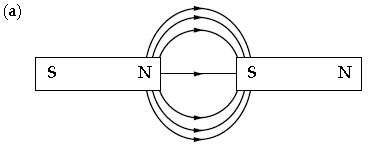
(b) Degree of closeness indicates that the relative strength of the magnetic field near the poles where the field lines are crowded is more as compared to other places.
Question: Can two magnetic lines of force intersect each other? Give reasons in support of your answer.
Answer: No, two magnetic lines of force never intersect each other. If two magnetic lines of force intersect each other than at the intersection there will be two different directions of magnetic field which is not possible.
Question: The deflection of the compass needle increases as it is moved towards the pole of a bar magnet. Why?
Answer: The magnetic field due to a bar magnet is highest near its two poles. Therefore, the force exerted by the bar magnet on the compass needle is larger in such a region. That is why the deflection of the compass needle increases when it is moved towards the pole of a bar magnet.
Short Answer Type Questions II
Question: The diagram given shows a current carrying loop a circular coil passing through a sheet of cardboard
at the points M and N. The sheet of cardboard is sprinkled uniformly with iron fillings.

(i) Copy the diagram and draw an arrow on the circular coil to show the direction of current flowing through it.
(ii) Draw the pattern of arrangement of the iron fillings when current is passed through the loop.
Answer: The direction of current is from M to N.
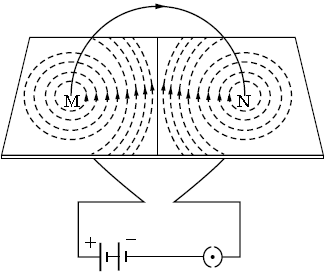
Question: (i) A straight wire conductor passes vertically through a piece of cardboard sprinkled with iron fillings as shown in the figure below. Copy the diagram and show the setting of iron fillings when a current is passed through the wire in the upward direction and the cardboard is tapped gently. Draw arrows to represent the direction of the magnetic field lines.

(ii) Name the law which helped you to find the direction of the magnetic field lines.
Answer; (i) The following diagram shows the magnetic field lines

(ii) The right hand thumb rule helps to find the direction of magnetic field lines.
Question: (i) Why does a magnetic needle show a deflection when brought close to a current carrying conductor?
(ii) A wire bent into a circle carries current in an anti-clockwise direction. What polarity does this face of the coil exhibit?
Answer: (i) A magnetic needle shows a deflection when brought close to a current carrying conductor, because the
magnet of the current carrying conductor exerts a force on the magnetic needle.

(ii) the face of the coil exhibits North polarity.
Question: (i) What is the name given to a cylindrical coil, whose diameter is less in comparison to its length?
(ii) A piece of soft iron is placed inside the current carrying coil, what is the name given to the device?
(iii) Give one use of the device named by you in part (ii) above.
Answer: (i) A cylindrical coil whose diameter is less in comparison to its length is also named as solenoid.
(ii) The name of the device is electromagnet.
(iii) The electromagnet is used in the electric bell.
Question: Explain briefly, how a magnet can be demagnetized using an alternating current.
Answer: To demagnetize magnet place it inside a long solenoid with its length in East-West direction. A 12 V AC supply is connected with a rheostat in series. Switch in the current, when AC is passed, its polarity changes due to which magnetic domains are reversed. Thus, it becomes randomly oriented and the bar loses its magnetism to a greater extent. Gradually, the current is reduced to zero by rheostat which makes the re-alignment if domains most difficult. Thus the bar of magnet is demagnetized.
Question: (a) Write the special name given to the coil AB which has many circular turns of insulated copper wire.
(b) List two factors on which the strength of the magnetic field produced by AB depends.
(c) What is the effect of placing an iron core in the coil AB?
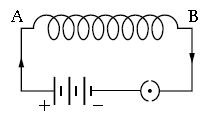
Sol. (a) Coil AB is solenoid.
(b) (i) Strength of the current.
(ii) Number of turns in the coil.
(c) The magnetic field associated with the
solenoid increases tremendously. It becomes
an electromagnet.
Question: State and explain Fleming’s right hand rule for the direction of induced current.
Answer: The direction of induced current in a straight conductor is given by Fleming’s right hand rule. It states that spread the thumb, forefinger and the middle finger of your right hand at right angle to one another in such a way that the forefinger points in the direction of magnetic field, thumb gives the direction of force, then the direction in which the middle finger points, gives the direction of induced current.
Question: (a) What is meant by a magnetic field ? Mention two parameters that are necessary to describe it completely.
(b) If field lines of a magnetic field are crossed at a point, what does it indicate?
Answer: (a) The space around the magnet or current carrying conductor with in which its influence can be felt by the magnetic substance. Magnitude and direction.
(b) It would indicate that at the point of intersection, compass needle would point to 2 directions which is impossible.
Question : Draw a diagram to show the magnetic field lines around a bar magnet. List any two properties of magnetic field lines.

(i) Two magnetic field lines never intersect each other.
(ii) Outside the magnet, the magnetic field lines are directed from North pole of magnet towards south pole.
(iii) The magnetic field lines at any one point gives the direction of magnetic field at that point.
Question: Explain the magnetic effects of current with the help of an activity along with labelled diagram.
Answer: Take a thick straight copper wire and place it between the points X and Y in an electric circuit. Place a small
compass near this wire. See the position of its needle. Pass the current through the circuit by inserting the key into the plug. Observe the change in the position of the compass needle.
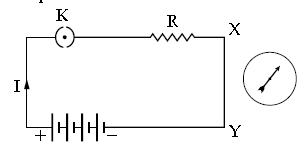
(Compass needle is deflected on passing an electric current through a metallic conductor)
Question: List the factors on which the magnetic field produced by a current carrying straight conductor
depends. State the rule which gives the direction of its magnetic field. Draw the pattern of magnetic field
lines due to a straight current carrying conductor.
Answer: Factors on which the magnetic field produced by a current carrying straight conductor depends :
(a) Current passing through the conductor.
(b) Distance of the magnetic compass from the conductor.
Right Hand Thumb gives the direction of magnetic field.
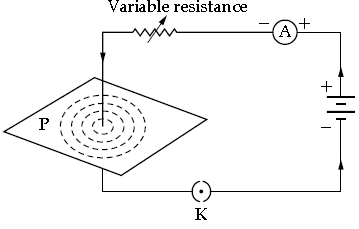
Question: Explain briefly two different ways to induce current in a coil. State the rule which determines the direction of induced current.
Answer: Two ways to induce current in a coil :
(i) If a coil is moved in a magnetic field.
(ii) By bringing a bar magnet close to the coil or taking away from it.
(iii) By rotating the coil in a uniform magnetic field.
Fleming’s Right Hand Rule : see Ans. of Q. 7.
Question: You are given a strong bar magnet and a compass needle. Describe an activity by which the magnetic
field lines due to the bar magnet can be drawn.
Answer: (i) Place the bar magnet on a sheet of white paper fixed on a drawing board. Mark the boundary
of the magnet.
(ii) Place the magnetic compass near the north pole of the given magnet.
(iii) Mark the position of two ends of the needle. Now move the needle to a new position such that its south pole occupies the position previously occupied by its north pole.
(iv) In this way proceed step by step till you reach the south pole of the given magnet.

(v) Join the points marked on the paper by a smooth curve. This curve represents a field line. Repeat the above steps for new positions of compass needle.
Question: What does the magnetic field pattern inside the solenoid indicate? State how this field be utilized
to make an electromagnet. List two ways by which strength of this magnet can be increased.
Answer: It indicates that the magnetic field is same at all points inside the solenoid. This property is utilized to magnetise a piece of magnetic material like soft iron when placed inside the coil. Two ways by which strength of electromagnet can
be increased :
(i) Increasing the amount of electric current through it.
(ii) Increasing the number of turns of the coil.
Question: The given figure shows a closed coil connected to a galvanometer G. The galvanometer shows
a deflection to the right when N-pole of the bar magnet is brought closer to the coil AB.

(i) Why does the deflection occur in the galvanometer?
(ii) State the observation when :
(a) The coil is moved away from N-pole
(b) Both the coil and magnet are moved to the right with the same speed.
Answer: (i) As the magnet is moved closer to coil AB, the flux linked with the coil increases. This set
up induced current in the coil as shown by deflection in the galvanometer.
(ii) (a) The direction of induced current in the coil AB is reversed and the galvanometer shows a deflection to the left.
(b) When both the magnet and the coil AB are moved towards right with the same speed, the flux linked with the coil does not change. No induced current is set up. Hence no deflection is shown by the galvanometer.
Question: (a) Shruti draws magnetic field lines close to the axis of a current carrying circular loop. As she
moves away from the center of circular loop, she observes that the lines keep on diverging. Explain the
reason for her observation.
(b) Write two properties of magnetic field lines.
Answer: (a) At every point of current carrying circular loop the concentric circles representing the magnetic field around it would become larger and larger as we move away from the wire because magnetic field becomes weaker at
larger distance.
(b) (i) the direction of magnetic field lines is from North to South outside the bar magnet and from South to North inside the magnet.
(ii) they never intersect each other.
Question: Temporary magnets and permanent magnets play an important role in our day to day life. A magnet has the ability to attract the magnetic elements. Permanent magnets are made of carbon steel, chromium steel and some alloys like Alnico and Nipermag. Permanent magnets are used in many objects which are necessary for our lives. Magnets are used in junk yard to make new cars and in roller – coasters too.
(i) State the objectives for this observation.
(ii) Estimate the values of electromagnets used by people around you.
Answer: (i) Objectives : To understand the need to have temporary and permanent magnets. To understand the need to use different materials for making magnets
(ii) Uses of electromagnets : Used in electric bells, loudspeakers, electric motors, telephone diaphragms, electric fan and for sporting scrap metal and for extraction in hospitals etc.
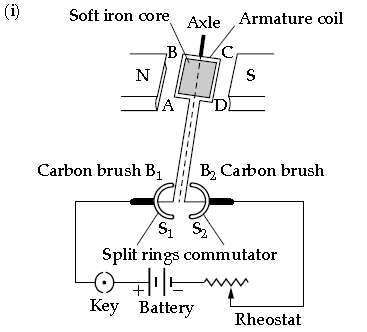
(ii) In DC motor, when the coil rotates, the split ring rotate with it to flow the current in the armature coil in such a way that it always keep on rotating in the same manner.
(iii) AC can be transported to a large distance without much loss.
Question: (i) State two ways by which the magnetic field of a solenoid can be made stronger?
(ii) What materials is used for making the armature of an electric bell? Give reason for using this material.
Answer: (i) Magnetic field of a solenoid can be made stronger by increasing
(a) The current in the solenoid.
(b) The number of turns in the solenoid.
(ii) Soft iron is used for making the armature of an electric bell, because soft iron is magnetized
easily on passing the current and completely demagnetized easily on withdrawing the current through the solenoid.
Question: Draw a sketch of an electric bell with electrical connection and label the main parts. Why is the
armature made of soft iron and not of steel?
Answer: The sketch of electric bell is shown as below :

Armature is made of soft iron because it gets easily demagnetized as soon as the current is switched off.
Question: Draw a representative diagram of a DC motor. Label the following in your diagram
(i) The field magnet (iii) Commutator
(ii) The armature (iv) Wire brushes
What is the energy change in this case?
Answer: The labelled diagram of DC motor is as shown below.

(i) The magnetic field is labelled as N-S. It is an electromagnet with concave pole pieces.
(ii) The armature coil mounted on an axle is labelled as ABCD.
(iii) The commutator is labelled as S1, S2.
(iv) Wire brushes are labelled as B1, B2. In an electric DC motor, the electrical energy is converted into mechanical energy.
Question: What is solenoid? Why do we usually keep its diameter small in comparison to its length?
Answer: If a conducting wire (coated with an insulating paint or varnish) is closely wound on a (long) cylindrical core, the resulting coil is referred to as a solenoid. It is usual to keep the diameter of the solenoid small compared to its length. This is done to bring about a greater degree of uniformity (and simplicity) in the (axial) magnetic field of the solenoid.

However if magnet points in some other direction but returns to North-South direction when the current is switched OFF, the magnetic field is due to some current-carrying conductor.
Electromagnetic Induction and Transformer
Short Answer type Questions
Question: State two causes of energy loss in a transformer.
Answer: (i) heat losses(copper losses)
(ii) Magnetic flux linkage loss.
(iii) Eddy current loss.
(iv) Hystersis loss.
Question: State the function of a transformer.
Answer: The function of a transformer is to increase or decrease the a.c. voltage. The step-up transformer increases the voltage whereas the step-down transformer decreases the voltage.
Question: Give two similarities an AC generator and DC motor.
Answer: Both in an AC generator and DC motor a coil rotates in magnetic field between the pole pieces of a powerful magnet/presence of carbon brushes/ presence of armature coil.
Question: (i) What is an AC generator or dynamo used for?
(ii) Name the principle on which it works.
Answer: (i) An AC generator or dynamo is used to convert mechanical energy into electrical energy.
(ii) It works on the principle of Faraday’s law of electromagnetic induction.
Question: Give two differences between a DC motor and AC generator.
Answer: The two differences between a DC motor and an AC generator are :
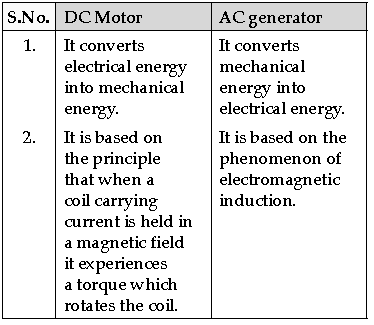
Question: A device is used to transform 12 V AC to 200 V AC
(i) What is the name of this device?
(ii) Name the principle on which it works?
Answer: (i) The name of this device is step-up transformer.
(ii) It is based on Faraday’s law of electromagnetic induction.
Question: State one point of similarity and one point of difference between an AC generator and a DC motor.
Answer: Similarity : In both the coil or armature moves or rotate in uniform magnetic field. Difference : See Ans. 5
Question: Draw a simple sketch of a step down transformer. Label the different parts in the diagram.
Answer: The sketch of step-down transformer is shown as below.

Question: State the energy change which takes place when a magnet is moved inside a coil having a galvanometer at its ends. Name this phenomenon.
Answer: When a magnet is moved inside a coil having a galvanometer at its ends the mechanical energy is converted into electrical energy. This phenomenon is known as electromagnetic induction.
Question: Mention two reasons, why a soft core is used within the coil of a moving coil galvanometer?
Answer: A soft core is used within the coil of a moving coil galvanometer, because of the following reasons :
(i) To make the field radial.
(ii) To concentrate the magnetic lines of force.
Question: State two ways by which the emf in an AC generator can be increased.
Answer: The emf in an AC generator can be increased by
(i) increasing the speed of rotation of the coil.
(ii) increasing the strength of magnetic field.
Question: Why do birds fly off a high tension wire when the current is switched ON?
Answer: When a high tension current is switched ON; induced currents are produced in the body of the bird, the nerve and circulatory system being conducting, the bird feels a repulsion and flies off.
Question: A step-up transformer is given a d.c. input of 100 V. What is the output voltage?
Answer: Zero. When input in d.c., there is no induced emf in secondary except at the switching ON or OFF in stands.
Question: In following figure magnet NS is moved towards coil with a speed of 2 m/s. the galvanometer shows
a deflection of 5% divisions. If speed of magnet is made 5 m/s, what is the likely deflection in the galvanometer?
Answer: The deflection in galvanometer G is due to induced emf in coil. The induced emf is directly proportional
to the speed of the magnet

Therefore, deflection in galvanometer 5 X 5 / 2
= 12.5 divisions
Question: A step-up transformer is given an input a.c. of 220 V, 50 Hz. The transformer ratio is 2. What is the output?
Answer: Let Vi and Vo denote the input and output voltage respectively. Then,

The frequency of output would be the same as the input. Therefore, output voltage is 440 V, 50 Hz.
Question: For an ideal step-up transformer of transformer ratio 2, the input power is 2 kW. The input a.c.
is 200 V, 50 Hz. What are the input and output currents?
Answer: PIN = Input power = VIN IIN
∴ 2000 = 200 × IIN
∴ IIN = 10 A
Let Io be the output current. For an ideal transformer,

Question: What is the principle that governs the working of a transformer? Can a transformer work with
a d.c. source?
Answer: The functioning of a transformer depends on the phenomenon of electromagnetic induction. A transformer will not work with a d.c. source.
Question: Give the practical use of step-up transformer. which coil will have greater number of turns in a step-up transformer?
Answer: We use a step-up transformer to push up or step up the voltage of a given a.c. source. Secondary coil
has greater number of turns than primary coil.
Question: Give the methods through which one may increase the speed at which a d.c. motor is rotating.
Answer: We can increase the speed of rotation of a d.c. motor by
(i) Increasing the current flowing through its coil.
(ii) Increasing the strength of the magnetic field in
which the coil is rotating.
Question; What two characteristics of the primary coil make it different from the secondary coil for a step-up
transformer?
Answer: For a step-up transformer, the primary coil :
(i) Has a smaller number of turns of wire than the secondary coil.
(ii) Has to be made from a thicker (or lower gauge number) wire than the wire needed for making the secondary coil.
Question: Give the principle of operation of a d.c. motor. Also state the energy change that takes place in it.
Answer: The principle of operation of a d.c. motor (as well as a moving coil galvanometer) is the following :
When a current-carrying coil is present in a magnetic field, it experiences a torque that tends to rotate it.
A d.c. motor helps us to convert electrical energy into mechanical energy.
Short Answer Type Questions II
Question: (i) Name the transformer used in the power transmitting station of power plant.
(ii) What type of current is transmitted from the power station?
(iii) At what voltage is this current available to our household?
Answer: (i) Step up transformer
(ii) Alternating current
(iii) 220 V
Question: (i) Name the device to increase the voltage at a generating station.
(ii) At what frequency is AC supplied to residential houses?
(iii) Name the wire in a household electrical circuit to which the switch connected.
Answer: (i) Step up transformer
(ii) 50 hertz
(iii) Live wire
Question: (i) Draw a neat and labelled diagram to show the structure of a generator.
(ii) State the energy conversion taking place in the AC generator when it is working.
Answer: (i) The labelled diagram of an AC generator is shown in figure :
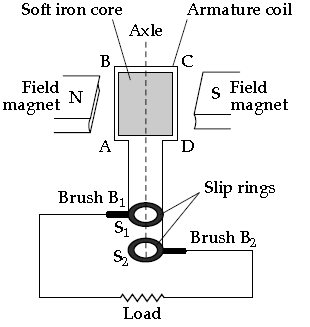
(ii) In the AC generator, mechanical energy of the rotation of the coil converts into electrical energy.
Question: (i) State two factors on which the strength of an induced current depends.
(ii) When a solenoid carrying current is freely suspended, it comes to rest along a particular direction. Why does this happen?
Answer: (i) The two factors on which the strength of an induced current depends :
(a) Rate of change of magnetic flux within the closed coil.
(b) Number of turns in coil.
(ii) A solenoid carrying current behaves like a bar magnet. When it is freely suspended it points
in North-South direction.
Question: Show on a diagram the various components of a step-up transformer.
Answer: The required diagram is shown below :
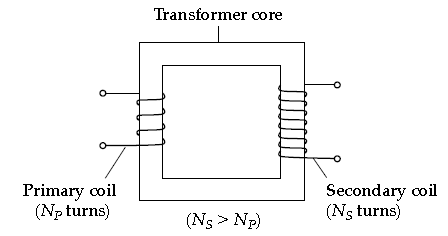
Question: Draw a labelled diagram of a simple a.c. generator.
Or
Give a simple sketch of an a.c. generator and label its parts.
Answer: Labelled diagram of a simple a.c. generator is shown in the following figure :
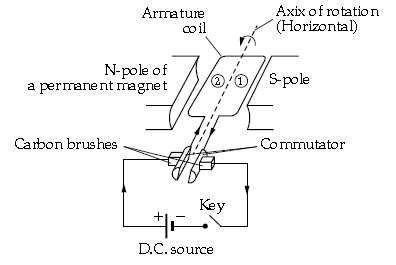
Question: Draw a labelled diagram of a simple d.c. motor.
Answer: The labelled diagram of a simple d.c. motor is shown below :
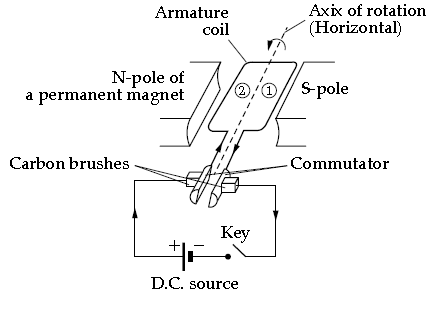
Long Answer Type Questions
Question: From the diagram given below :
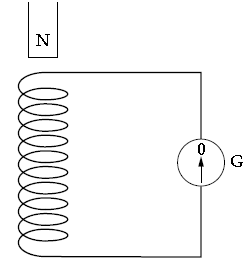
(i) What will you observe when:
(i) the magnet is dropped into the coil,
(2) the number of turns of the coil is increased ?
(ii) What will be the direction of current flowing through the coil when the magnet is dropped in (clockwise or anticlockwise)?
(iii) State the law which explains this observation.
Sol. (i) (1) As the magnet enters in the coil, a momentary deflection is observed in the galvanometer.
(2) On increasing the number of turns in the coil, the deflection as observed in part (1) increases.
(ii) From the above we can say, the direction of urgent will be anticlockwise.
(iii) According to Lenz’s law, the current induced in the coil is such that it opposes the cause of its origin. As a result the end of coil near the N pole of magnet becomes north pole. 2+2
Question: Draw a labelled diagram of an alternating current generator. Write the function of its two main parts.
Answer: The labelled diagram is shown below

(i) Brushes The function of brushes is to pass on current form the armature coil to the external load resistance R.
(ii) Field magnets To produce strong magnetic field.
Question: (i) Name two factors on which magnitude of an induced emf in the secondary coil depends.
(ii) In the following diagram an arrow shows the motion of the coil towards the bar magnet.

(a) State in which direction the current flows, A to B or B to A?
(b) Name the law used to come in the conclusion.
Answer: (i) The two factors on which magnitude of an induced emf in the secondary coil depends are :
(a) The change in magnetic flux.
(b) The time in which magnetic flux changes
(ii) (a) The current flows from A to B.
(b) The law used to come to the conclusion is Lenz’s law.
Question: (i) Draw a labelled diagram to show the various components of a step-down transformer.
(ii) State the main differences between a step-up and step-down transformer.
Answer:

(ii) The difference between step-up and stepdown transformer are as follows :

Question: The diagram shows a coil connected to a galvanometer G. The galvanometer shows a deflection occur in the galvanometer?
(i) Explain, why the deflection occur in the galvanometer?

(ii) Does the direction of the current in the coil appear clockwise or anticlockwise when viewed from the end A?
(iii) State the observation in G when the coil is moved away from N.
(iv) State the observation in G when both the coil and the magnet are moved to the right at the same speed.
Answer: (i) The deflection in the galvanometer occurs due to the magnet, these happen when change in
magnetic flux is linked with the coil. As a result emf induced across its ends due to which induced current in the coil.
(ii) The direction of the current in the coil is anticlockwise, when viewed from the end A.
(iii) When the coil is moved away from N, the needle of galvanometer shows deflection to its left side.
(iv) When both the coil and magnet are moved to the right at the same speed, we observe deflection as there is no change in magnetic flux linked with the coil.



